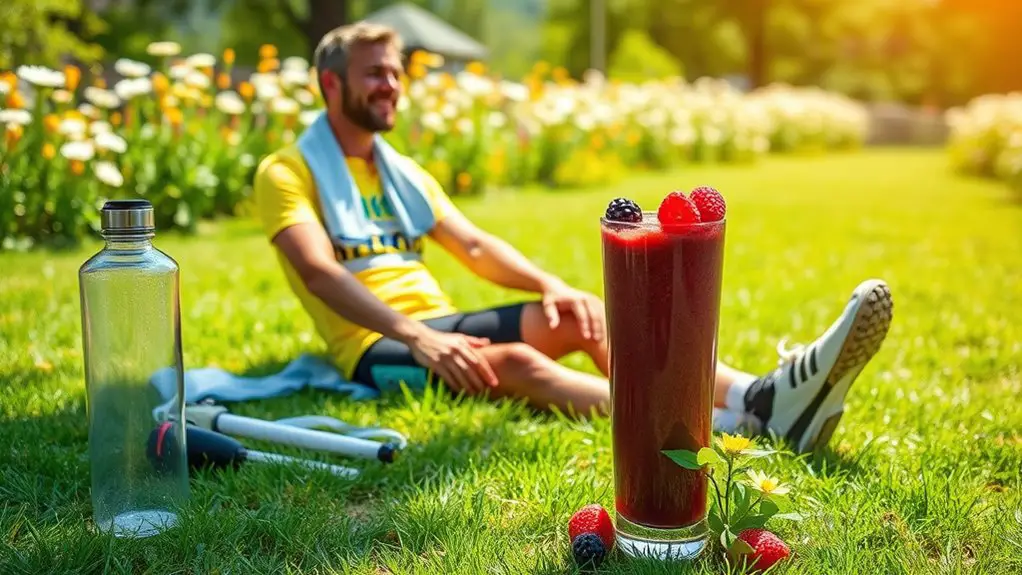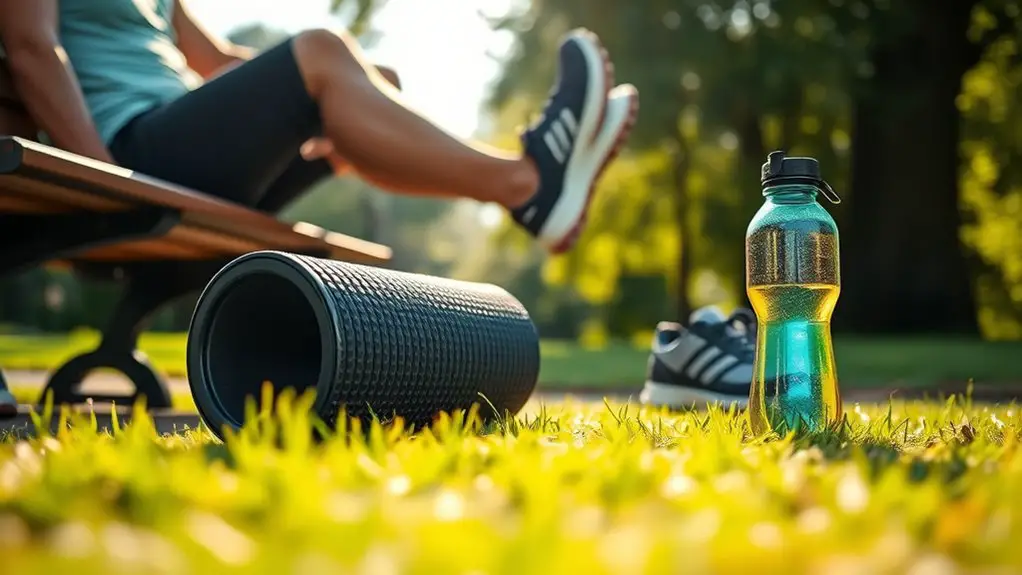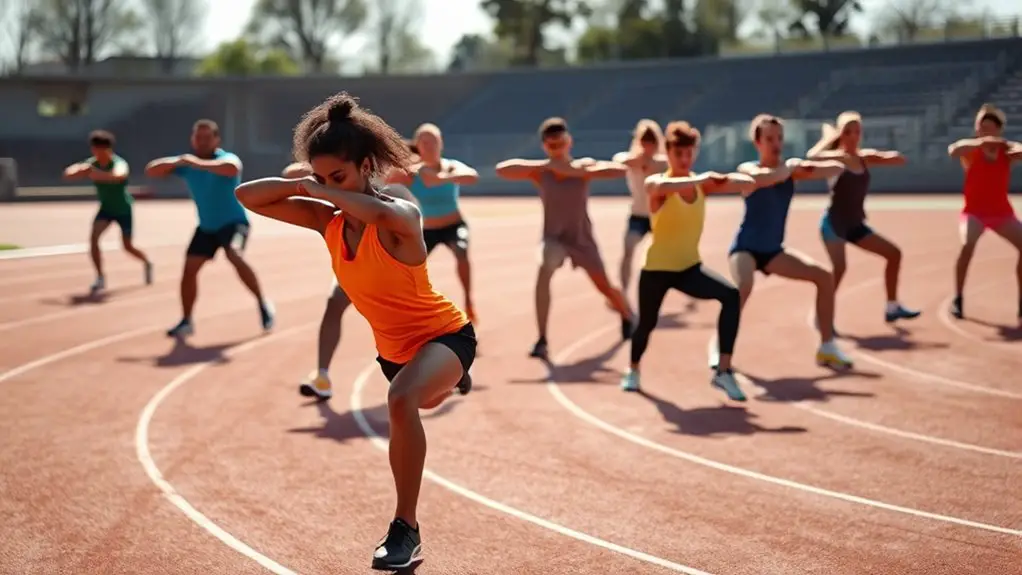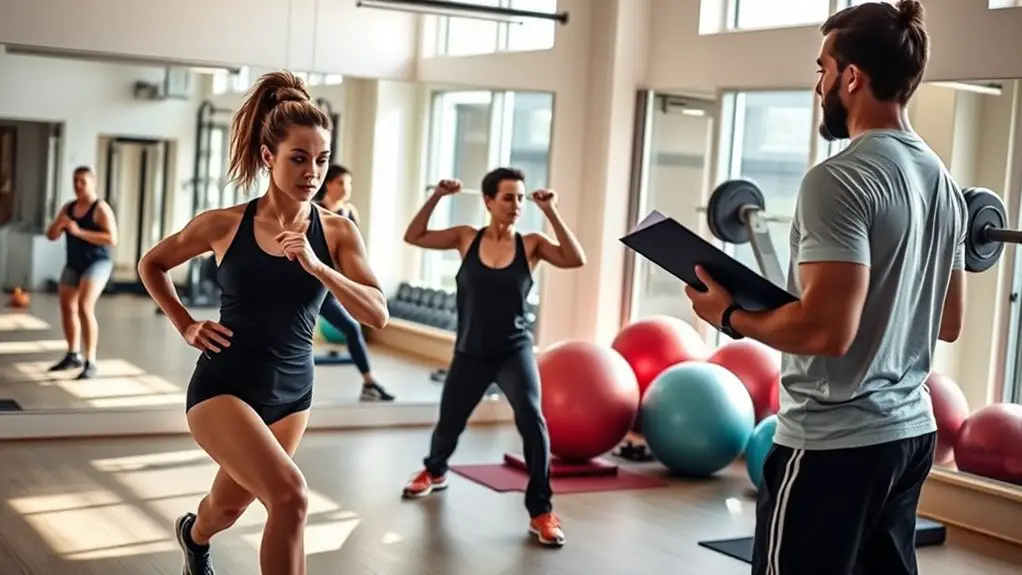To recover effectively from long-distance cycling, focus on nutrition by consuming carbohydrates and high-quality proteins soon after your ride. Stay hydrated to maintain performance, and prioritize quality sleep to aid muscle repair. Incorporate active recovery techniques like low-intensity cycling, stretching, and foam rolling to relieve tension. Additionally, nurture your mental health through visualization and community connection. Explore these strategies further, and you'll enhance your overall cycling experience.
The Importance of Recovery for Cyclists
When you push your limits on long-distance rides, recovery becomes essential for maintaining performance and preventing injuries. Your body needs time to repair those hardworking muscles after hours in the saddle. It's during these recovery periods that muscle repair happens, allowing you to grow stronger and more resilient for future rides. Ignoring recovery can lead to fatigue, burnout, or even serious injuries that could hold you back from the freedom of the open road.
Listen to your body—if you feel soreness or fatigue, take a step back. Incorporate rest days into your routine, and consider gentle activities like stretching or yoga to promote blood flow. This isn't just about short-term relief; it's about building a sustainable cycling journey. Embrace recovery, and you'll find yourself riding longer and enjoying every mile with renewed energy and passion. After all, the road to freedom is best traveled when you're in top shape. Taking time off enhances motivation is crucial for maintaining your cycling journey and overall well-being.
Nutrition Strategies for Optimal Recovery
After long-distance rides, what you eat can greatly impact how effectively your body recovers. To maximize your recovery, focus on these key nutrition strategies:
- Carbohydrate Timing: Consume carbohydrates within 30 minutes post-ride to replenish glycogen stores quickly.
- Protein Sources: Include high-quality protein, like lean meats, eggs, or plant-based options, to repair muscle damage.
- Balanced Meals: Aim for a mix of carbs and proteins in your meals to support overall recovery and energy levels.
- Snack Smart: Grab a recovery snack, like a smoothie or yogurt with fruit, to keep your energy flowing until your next meal. Incorporating adequate protein intake can significantly reduce soreness and accelerate recovery time.
Hydration: Keeping Your Body in Balance
Staying properly hydrated is essential for your performance and recovery during long-distance rides. You need to maintain a balance of electrolytes while cycling, and it's equally important to replenish fluids after your ride. Let's explore how to keep your body in balance through effective hydration strategies. Replenishing lost electrolytes during endurance activities is crucial to prevent fatigue and stamina loss.
Importance of Electrolyte Balance
Maintaining electrolyte balance is essential for ideal performance during long-distance cycling, as it directly influences your hydration levels and overall stamina. When you sweat, you lose electrolytes, which can lead to imbalances that affect your ride. To keep your body in check, consider these key electrolyte sources:
- Bananas – Great for potassium, helping muscle function.
- Sports drinks – Quick replenishment of sodium and other electrolytes.
- Nuts and seeds – Packed with magnesium, vital for energy production.
- Coconut water – A natural source of electrolytes, invigorating and hydrating.
Hydration During Rides
Electrolyte balance is just one piece of the puzzle when it comes to optimizing your performance on long rides. To truly embrace the freedom of the open road, you gotta nail your hydration strategies. Don't fall for hydration myths that suggest chugging water alone suffices. Instead, consider the balance of fluids and electrolytes.
| Hydration Strategy | Description |
|---|---|
| Sip Regularly | Take small sips every 15-20 mins |
| Electrolyte Drinks | Use drinks with sodium & potassium |
| Water Intake | Aim for 500-750 ml per hour |
| Monitor Urine Color | Light yellow means you're good |
| Adjust for Conditions | Hot or humid? Increase intake! |
Stay aware, stay hydrated, and ride free!
Post-Ride Fluid Intake
After a long ride, replenishing lost fluids is crucial for recovery and overall performance. You want to guarantee your body's in balance, so here are some effective post-ride hydration techniques and ideal fluid choices:
- Water: The simplest and most effective choice to rehydrate.
- Electrolyte Drinks: These help restore lost salts and minerals, especially after intense rides.
- Coconut Water: A natural option packed with electrolytes and less sugar than sports drinks.
- Smoothies: Blend fruits, yogurt, and a splash of water for hydration plus nutrients.
Choosing the right fluids can make a significant difference in your recovery. So next time, remember to hydrate wisely and feel the freedom to ride even farther!
The Role of Sleep in Recovery
While you might focus on nutrition and hydration during long-distance cycling, sleep plays a crucial role in your recovery process. Prioritizing sleep quality and duration is essential for optimizing your recovery cycles. Aim for a restful sleep environment—dark, cool, and quiet—to enhance deep sleep and REM sleep, where your body repairs itself.
Practicing good sleep hygiene, like keeping a consistent bedtime and limiting screen time before bed, helps regulate your circadian rhythm. If you're feeling fatigued, don't underestimate the napping benefits; a short nap can recharge your energy and boost performance. Quality sleep also reduces inflammation, which can significantly improve your strength and endurance on the bike.
Be mindful of potential sleep disorders that could disrupt your rest. By embracing these strategies, you'll not only recover faster but also enjoy the freedom that comes with being fully prepared for your next ride. Trust in the power of quality sleep to elevate your cycling experience!
Active Recovery Techniques
Active recovery techniques are essential for helping your body bounce back after long rides. Incorporating stretching and mobility exercises, along with low-intensity cycling sessions, can considerably enhance your recovery process. These strategies not only reduce muscle soreness but also improve your overall flexibility and performance. Additionally, active recovery boosts blood flow, which is crucial for effective recovery and helps in delivering essential nutrients to your muscles.
Stretching and Mobility Exercises
Though you may feel tempted to skip stretching after a long ride, incorporating mobility exercises into your recovery routine can greatly enhance your overall performance. To keep your body feeling free and flexible, try these effective techniques:
- Dynamic stretching – Warm up your muscles before your next ride with gentle movements.
- Static stretching – Post-ride, hold stretches to lengthen your muscles and improve flexibility.
- Mobility drills – Perform exercises that enhance joint range of motion and reduce stiffness.
- Foam roller techniques – Use a foam roller to release tension and promote blood flow.
Consider adding recovery yoga for a holistic approach. These flexibility routines are essential for maintaining peak performance and enjoying the freedom of cycling!
Low-Intensity Cycling Sessions
Engaging in low-intensity cycling sessions can be a game-changer for your recovery routine, especially after grueling rides. These recovery rides allow you to pedal at a relaxed pace, promoting blood flow and reducing muscle soreness without putting added stress on your body. The low intensity benefits include quicker recovery, improved circulation, and a boost in overall endurance, letting you bounce back faster for your next adventure. Plus, they're a fantastic way to enjoy the freedom of the open road while still aiding your body's healing process. So, jump on your bike, embrace the gentle rhythm, and let those easy rides rejuvenate your spirit and legs alike. Your body will thank you, and you'll be ready for more challenges ahead!
Stretching and Flexibility Exercises
Although many cyclists focus on endurance and strength training, incorporating stretching and flexibility exercises into your recovery routine is essential for maintaining peak performance. By enhancing your flexibility, you can improve your range of motion and reduce the risk of injury, allowing you to ride with freedom. Here are some effective strategies:
Incorporating stretching and flexibility exercises is vital for cyclists to enhance performance and reduce injury risk.
- Dynamic stretching: Do this before rides to warm up your muscles and increase blood flow.
- Static stretching: After your rides, hold stretches for 15-30 seconds to improve overall flexibility.
- Flexibility drills: Incorporate simple movements that target key muscle groups, like hip flexors and hamstrings.
- Yoga poses: Try poses like Downward Dog and Pigeon to help lengthen tight muscles and promote relaxation. Additionally, prioritize post-workout stretching as part of your routine to enhance recovery and prevent injuries.
Massage and Foam Rolling Benefits
After focusing on stretching and flexibility exercises, it's important to contemplate how massage and foam rolling can further enhance your recovery. These techniques can be game-changers for your muscles after long rides. Massage techniques, whether self-administered or professional, help alleviate tension and improve blood circulation, allowing your body to heal faster. You'll feel those knots loosening up, which can lead to less soreness and quicker recovery times.
Foam rolling, on the other hand, is a fantastic way to enhance mobility and flexibility. By applying pressure to tight spots, it promotes muscle elasticity and breaks down adhesions. It's like giving your muscles a mini massage, right when they need it most. Incorporating both massage and foam rolling into your routine can empower you to ride longer and more freely without the nagging tightness. Additionally, foam rolling can enhance muscle recovery by promoting blood flow and reducing soreness. So, roll it out and get that massage—your legs will thank you!
Mental Recovery: The Psychological Aspect
While physical recovery is essential after long-distance cycling, mental recovery plays an equally important role in your overall performance. Cultivating mental resilience can help you tackle future rides with confidence. Here are some strategies to enhance your mental recovery:
- Positive Visualization: Imagine yourself conquering your next ride, feeling strong and free. This technique boosts motivation and reinforces your ability to succeed.
- Journaling: Reflect on your experiences, noting what went well and what you can improve. This self-awareness will guide your future rides.
- Meditation: Spend a few minutes in silence, focusing on your breath. It can help clear your mind and reduce anxiety, promoting mental clarity which is essential for optimal performance.
- Connect with Fellow Cyclists: Share stories and experiences. Building a supportive community can uplift your spirits and foster a sense of belonging.
Monitoring Your Recovery Progress
Once you've focused on mental recovery, it's crucial to keep track of how well you're bouncing back from your long-distance rides. Monitoring your recovery progress can help you regain that sense of freedom you crave on the open road. Start with recovery tracking tools like apps or journals that log your rides, sleep quality, and nutrition. These records are important progress indicators that reveal how your body responds over time.
Pay attention to how you feel during your next ride. Are you more energized? Is your endurance improving? These subtle changes tell you whether your recovery strategies are working. Don't shy away from adjusting your routine; freedom comes from finding what truly works for you. By actively tracking your recovery, you empower yourself to push boundaries, ensuring each ride leaves you feeling rejuvenated and ready for the next adventure. Embrace this process, and watch your cycling journey flourish. Additionally, incorporating proper nutrition strategies can significantly enhance your recovery experience.
Frequently Asked Questions
How Often Should I Incorporate Rest Days Into My Cycling Routine?
Did you know that athletes who incorporate rest days effectively can improve their performance by up to 20%? To optimize your cycling routine, aim for rest day frequency of 1-2 days per week, depending on your intensity and mileage. This recovery schedule lets your body repair and strengthen, helping you enjoy your rides even more. Listen to your body, and don't hesitate to take a break when you need it; freedom comes with balance!
What Are the Signs I'm Overtraining and Need Recovery?
If you're feeling unusually fatigued, irritable, or experiencing a drop in performance, those could be overtraining symptoms. You might also notice disrupted sleep or persistent muscle soreness. These are strong recovery indicators that your body needs a break. It's crucial to listen to yourself; freedom in your cycling journey means recognizing when to rest. Embrace those recovery days to recharge, so you can get back to enjoying the ride without limits.
Can I Use Recovery Strategies for Other Sports Besides Cycling?
Absolutely, you can use recovery strategies from cycling in other sports. In fact, studies show that athletes who incorporate cross-training see up to a 20% improvement in overall performance. Recovery techniques like proper hydration, stretching, and rest days are universal. They help your body heal, regardless of the sport. So go ahead, mix it up! Embrace the freedom of exploring different activities while ensuring you recover effectively. Your body will thank you!
How Does Aging Affect Recovery Time for Cyclists?
Aging affects recovery time for cyclists in several ways. As you age, your body may respond slower to stress, which can extend recovery times. You'll notice that effective recovery techniques become even more vital. Incorporating rest days, proper nutrition, and gentle stretching can help you maintain your freedom on the bike. Embracing these strategies will guarantee you continue enjoying long rides while adapting to the aging effects on your body.
What Role Do Supplements Play in Recovery for Cyclists?
Supplements can be your secret weapon in recovery—almost like a magic potion! They help you optimize protein timing, ensuring your muscles get the nutrients they crave right when they need them. Plus, maintaining electrolyte balance is essential for keeping your energy levels up. By smartly integrating supplements into your routine, you can feel free to push your limits, knowing you're fueling your body for the next adventure ahead.




